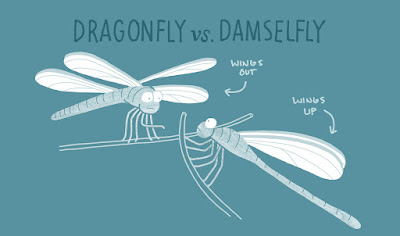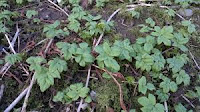Click here for the 'Seeds of Eaden' seed shop
A weed is defined any wild plant that grows in an
unwanted place, especially in a garden or field where it prevents the
cultivated plants from growing freely. However weeds can include any unwanted vigorous
cultivated plants that have spread or set seed in your border.
That doesn't always
help when weeding the garden as we can be reluctant to remove plants we do not
normally categorise as weeds. One of the biggest complaints about
gardeners is that they have a lack of understanding of which plants are
unwanted and have removed precious plants along with the weeds.
There are some typical British weeds that grow in
gardens that can be easily identified and will enable you to decide which plant
to remove and which to keep. These include annual weeds such as
chickweed, growing and setting seed in a single year and are easy to remove by
manual cultivation techniques such as hoeing. Perennial weeds such
as dandelions have a life cycle beyond a year and are tougher to eradicate,
often requiring digging out of chemical control.
 Dandelion (Taraxacum
officinale)
Dandelion (Taraxacum
officinale)
With its distinctive toothed leaves that give
it its names dandelion (teeth of lion), this rosette shaped weed
has distinctive yellow flowers followed by dandelion clocks.
Dandelions have a long tap root from which new plants can grow. Larger
weeds will require chemical control with glyphosate but smaller weeds can be
removed with a trowel if the long tap root is removed too.
Creeping thistle (Cirsium arvense)
Creeping thistle loves grassland
and uncultivated soil. It can quickly spread and once established it can
be difficult to eradicate permanently. Spreading by creeping roots and airborne
seeds, repeated digging out of roots reduces the problem but chemical control
will provide a quicker solution.
Chickweed (Stellaria media)
This annual weeds quickly spreads out and smoothers
other seedlings. Thriving in rich soils it sets seed quickly.
Remove it promptly by hand or using a hoe.
Shepherds purse (Capsella bursa-pastoris)
This annual weed forms a rosette, sending up
characteristic heart-shaped seed pods after white flowers.
Remove potential plants as soon as you see them and remove seed heads
as soon as you spot them as seeds can live for up to 30 years in the soil.
Groundsel (Senecio vulgaris)
This annual weed produces seeds all year round,
which are spread by the wind. Although hoeing seedlings is effective,
remove larger uprooted plants as these can still set seeds that germinate.
Stinging nettle (Urtica
dioica)
This perennial nettle
is usually considered to be weeds, although if you have the space to leave
some, they can be an excellent source of food and habitat for butterflies such as the red admiral, peacock and small
tortoiseshell. Stinging nettles thrive in loose, newly cultivated
soil, especially where phosphate levels
are high. Cut down in mid-summer before flowering to prevent setting of
seed and remove by cultivation or chemical control.
Annual Nettle (Urtica urens)
Smaller than its larger big brother the stinging
nettle, this nettle favours rich, fertile soil such as well-manured vegetable
gardens. If you remove by hand, wear gloves to avoid stings.
Hairy bittercress (Cardamine hirsuta)
This annual weed is low growing but can spread
significantly in borders. Short flower stems can propel seeds several feet away
do remove the plant as soon as you spot it.
Bindweed (Calystegia sepium)
This weed quickly swamps other plants with its
climbing, twisting stems and has distinctive white trumpet flowers. Pull
by hand to remove from other plants and then treat with glyphosate.
Japanese knotweed (Fallopia japonica)
This weed is invasive, and I mean invasive.
Japanese knotweed used to be such a concern it was once a notifiable
weed, but is now much more common and that status has been removed. It
can take up to five years to eradicate this plant with chemical control.
Luckily enough, this plant is herbaceous and dies down in the winter and is
infertile, spreading by underground rhizomes only.
Do not cut, mow or spread any of the weed as new
plants can grow from just a few millimetres of plant material.
Instead treat chemically with glyphosate in midsummer and then
again in the autumn, as the stems are dying down.
Ground elder (Aegopodium podagraria)
Ground elder sends out underground rhizomes, which
wind around garden flowers and strangle them. Gently pull the underground stems
to remove from the soil, repeating if necessary, or apply a glyphosate-based weed
killer.
Field horsetail (Equisetum arvense)
Similar to its water loving cousin Mares tail, this
weed can spread rapidly in compacted soil and is difficult to control. Although digging out will weaken the plant large areas require chemical
control.
 Bramble
This prickly weed has sharp thorns which are a nuisance. Bramble bushes have long, thorny, arching shoots and root easily. They send up long, arching canes that do not flower or set fruit until the second year of growth. Cut back hard and dig out roots or treat with a chemical.
Bramble
This prickly weed has sharp thorns which are a nuisance. Bramble bushes have long, thorny, arching shoots and root easily. They send up long, arching canes that do not flower or set fruit until the second year of growth. Cut back hard and dig out roots or treat with a chemical.

Willow herb (Epilobium)
This common annual weed sets seed in the border quickly. However it is easy to pull up by hand, which is best done before the pink flowers set seed.
How to remove moss
Common British weeds
Giant Hogweed




























